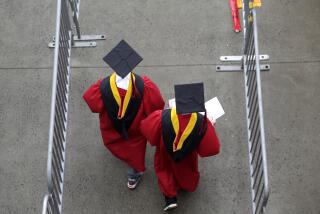Colleges Must Learn the ABCs of Economics
- Share via
Labor Day, summer’s end, and soon 12 million Americans will enter or return to the nation’s 3,300 colleges and universities--a higher education system that is at once a national asset, a profitable investment for students, and a source of anxiety for bill-paying parents.
The payoff, to put the good news first, is substantial. The difference between a college degree and a high school diploma these days is $600,000 in income over a working life, according to a new study by economics professors Finis Welch of UCLA and Kevin Murphy of the University of Chicago. Figuring 40 years at work, that’s a $15,000-a-year differential for college graduates--a premium that has grown in the last 10 years as the rise of service jobs demanded more of the technical and communications skills that college teaches.
So college is logical. But it’s not cheap. The average cost of private colleges is now $7,700 for tuition and fees--more than $11,000 including room and board. And the average understates the $17,000-plus tuition and expenses of such schools as Stanford, USC, Harvard, Yale and Dartmouth.
Public schools, where taxpayers shoulder 80% to 90% of the cost, charge less, but tuitions are mounting there also. The University of California system--at $1,492 tuition for state residents--remains a relative bargain, but Michigan is up to $2,900 per year and Ohio State is $2,440. Add in $3,000 to $4,000 for room, board and expenses, and you have $5,000 to $7,000 a year at a state-run college.
Yet costs continue to rise, constantly and rapidly. In a generally non-inflationary decade, college tuitions have more than doubled and experts foresee 7% annual growth in the next few years.
Why are costs rising? Bureaucracy, charges Bruce M. Carnes, deputy undersecretary of education, who notes that college administrative costs--but not teaching costs--are mounting. “There’s a proliferation of associate deans and provosts of all kinds,” says Carnes.
That’s an oversimplification, says Richard Rosser, president of the Assn. of Independent Colleges and Universities, which represents 1,500 private schools. Costs are rising because of the need to install computer labs, says Rosser, and most of all because of the expansion of student services.
‘Services’ Could Be Scrapped
Services? “Career counseling, drug and alcohol counseling,” explains Rosser, “plus remedial reading and financial aid.” Students must also be counseled on choice of courses and job availability, says Pat Smith, a spokeswoman for the American Council on Education. “In today’s diverse college population, you can’t expect many students to get such counseling at home,” she explains.
Clearly, colleges tap parents and taxpayers for more than education these days--for clinics to treat drinkers and dopers and for counseling of all kinds. It stands to reason a lot of that could be dispensed with in the interest of economy--poor kids have made it through college before without counselors holding their hands.
But reform will come slowly, while many people are faced with the immediate issue of how to pay for college. On that score, government guaranteed student loans are still available--$13 billion worth this year. So is financial aid from the colleges themselves, which use alumni endowments and the tuition of full-paying students to help those who can’t afford to pay. Most such aid is on the basis of need and unavailable if family income is $40,000 or above.
Otherwise, many states including California are watching Michigan’s pay-now, learn-later program in which parents’ investments earn tax-deferred interest in a trust fund guaranteed to cover tuition when the child reaches college age. Pittsburgh’s Duquesne University pioneered the “tuition futures” idea three years ago, but has suspended its program because investment earnings couldn’t keep up with college costs.
Meanwhile, both parties support tax-exempt bonds for education.
Which is not a bad idea. Higher education surely serves a national purpose; for many, especially poorer kids, it opens the door to America. But before more financing is found, colleges should get their costs under control. Noble purposes can also be served efficiently.
More to Read
Sign up for Essential California
The most important California stories and recommendations in your inbox every morning.
You may occasionally receive promotional content from the Los Angeles Times.










